The big data explosion is finally here.
We’ve gone from no phones, to flip phones, to iPhones that let you buy groceries, make a stock trade, or even watch a movie on Netflix.
We are all using our phones more often and consuming more and more data.
In fact, mobile data usage has increased by nearly 60% per year for the last fifteen years!
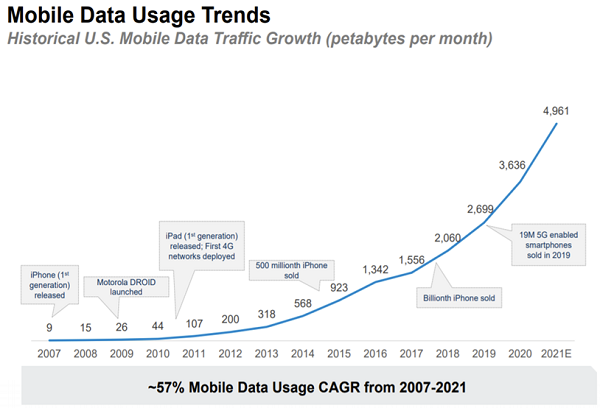
Source: AMT Investor Presentation
It is however the advent of new technologies that have helped improve our access to things that might have once been considered unimaginable.
Enter 5G, which is known as the ‘fifth-generation mobile network’, and the newest technological evolution which will greatly improve speeds (up to 100x), responsiveness, and the ability to connect more devices.
This isn’t just important for letting you stream Netflix shows faster, but is key to helping support innovation happening across the globe, in areas such as autonomous driving, industrial IoT (internet of things), and smart communities.
“In the future, everything is going to be transformed by 5G. The pace of technological change in decades past has been fast. The only thing we know for sure is that, in the future, it’s going to be even faster. We’re going to experience a technological shift that will transform people, businesses, and society as a whole.”
– Verizon CEO Hans Vestberg
One way that investors can play into this explosion in data and the ultimate rollout of 5G networks is via the three publicly traded cell tower operators, American Tower (AMT), Crown Castle (CCI), and SBA Communications (SBAC).
These companies are basically the landlords for the major telecom companies such as Verizon (VZ), AT&T (T), and T Mobile (TMUS), leasing space on their towers and collecting rents to help facilitate the buildout of 5G technologies.
All three have outperformed the broader REIT market by a significant amount in recent years, but I still think there is good appreciation potential for all three. Let’s take a closer look.
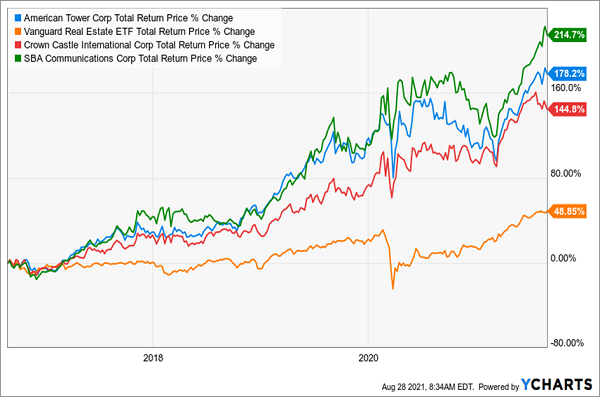
Note that cell-tower REITs typically haven’t offered significant yields, due to the fact that the stock prices have continued to outpace dividend growth! Thus for anyone that needs to clip a big coupon, these aren’t the best options, but if you’re happy with market-beating total returns via capital appreciation and consistent dividend growth, these REITs will suit you just fine.
5G REIT #1: American Tower (AMT)
Dividend Yield: 1.7%
AMT owns over 210K vertical towers and leases out space on the towers to telecom providers. Multiple tenants can occupy space on the tower and install their own communication equipment to help connect customers. These leases are long-term in nature and provide a reliable and predictable stream of cash flow.
One of the things I love about the tower business is that the returns on investment for one tower keep expanding as more tenants are added. Building out a tower with one tenant isn’t all that profitable for AMT, as it only results in a 3% ROI. But, AMT can keep adding new tenants, increasing its revenues and its ROI. With three tenants, AMT earns a 24% ROI!
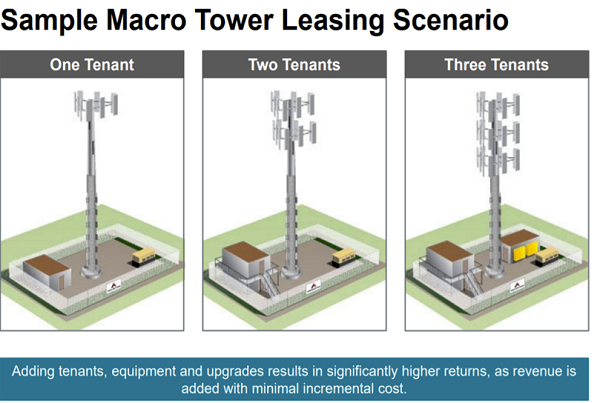
Source: AMT Investor Presentation
With the advent of 5G, AMT has seen even stronger demand for space on its towers, as wireless carriers continue to invest in 5G buildouts. An important note is that in order to achieve the full effects that 5G offers, the networks need to be DENSER, meaning more access points for the network on the towers.
If you have a new iPhone 12 or any 5G capable phone, you probably haven’t noticed much in terms of drastic speed improvements. It’s because the 5G buildout is still early in its infancy.
“And we believe that substantial further densification efforts will be necessary to augment existing 4G deployments and upcoming 5G rollouts. Just like in the United States, as higher band spectrum is deployed for 5G, networks will need to become denser to provide a true 5G experience.”
– AMT CEO Tom Bartlett, Q2 Earnings Call
AMT has shown strong, consistent growth over time, and I think these trends only grow stronger from here as telcos continue to invest in building out their 5G capabilities. Note that AMT is highly diversified internationally too, with 43% of revenues derived from outside the US.
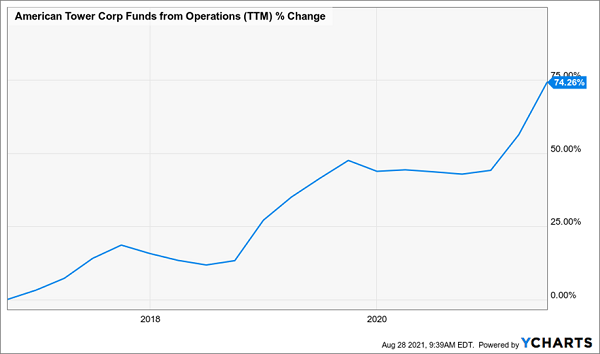
Valuation-wise, AMT trades at roughly 28x Funds from Operations which is above longer-term company averages, but roughly in line with other competitors such as Crown Castle and SBA. They offer a 1.8% yield and the dividend has grown by over 130% in the past five years.
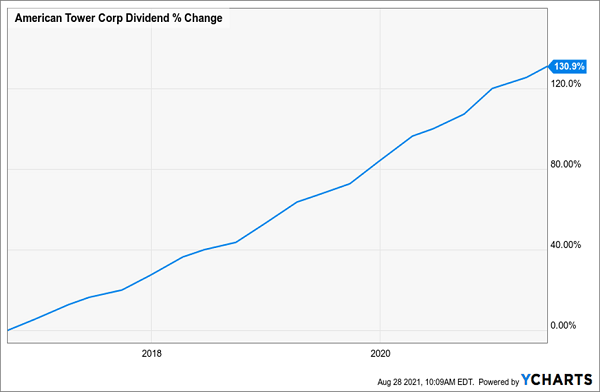
5G REIT #2: Crown Castle (CCI)
Dividend Yield: 2.7%
CCI is another cell-tower REIT that has 40,000 cell towers and 80,000 on-air small-cell nodes.
Small cells are antennas that are typically deployed on streetlights or utility poles. They work in tandem with towers to help offload data and improve connectivity and DENSITY!
Crown Castle has taken a bit of a more diversified approach to AMT, which is heavily focused on towers. Crown Castle has invested heavily in fiber networks to help deploy small cell sites in addition to its portfolio of towers.
CCI’s management believes that its strategy is the right one, although some point to the heavy expenditures that CCI has committed to fiber investments and the lower overall returns relative to towers.
However, based on results, CCI has grown FFO at a better clip than AMT, and recent results show strong 5G related demand.
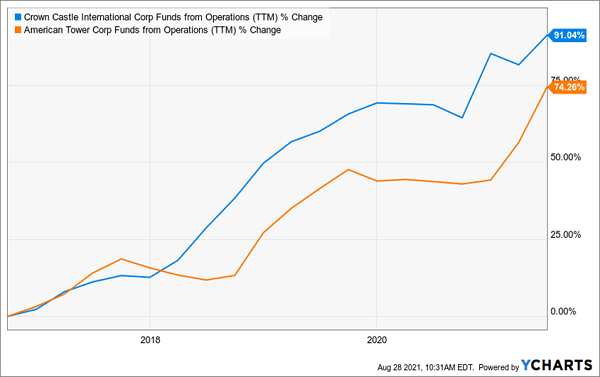
CCI trades at 26.6 times Funds From Operations, a discount in comparison to its closet peer, AMT. It also offers a higher dividend yield at 2.8%, with 50% dividend growth over the past five years.
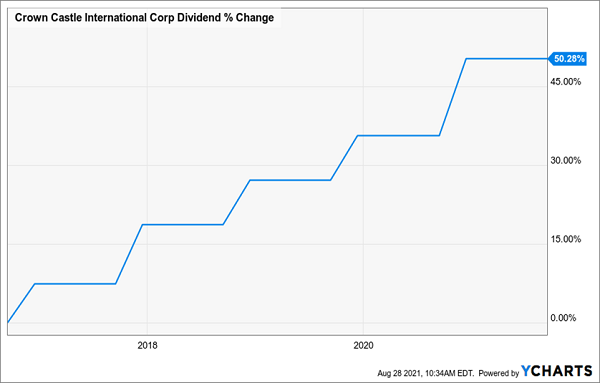
Consider CCI as a solid, diversified way to play into the future growth of 5G and the need to improve density across networks.
5G REIT #3: SBA Communications (SBAC)
Dividend Yield: 0.6%
SBAC is the third-largest US wireless tower operator and more of a domestic tower pure play in comparison to AMT and CCI, with US-based towers accounting for 75% of SBA’s revenue.
Its core revenues are derived from the big four domestic telcos – T, TMUS, VZ, and Dish Network (DISH) Those on the street are more optimistic about domestic-based tower exposure, due to the instability of overseas markets.
Thus, SBAC is valued at a premium to both AMT and CCI, now trading at over 31x Funds From Operations. Its recent growth in FFO in comparison to competitors has helped justify this premium.
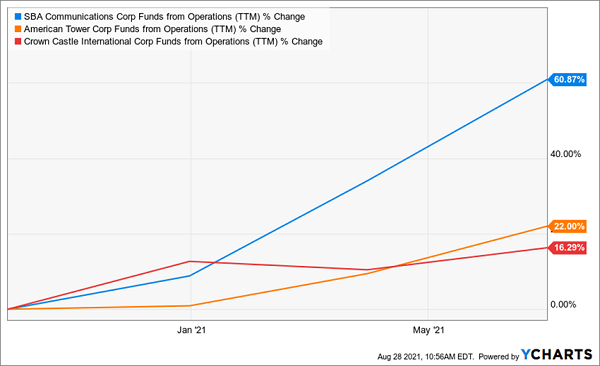
It noted on a recent call that it signed more new leasing revenue in 2Q than in any quarter for the past 7 years and generated 15% growth in FFO in the second quarter due to the strong demand for tower space.
It does offer the lowest dividend of the group at under 1%, but for investors looking for a solid, domestic-focused 5G growth play, SBAC looks like a solid choice.
AMT Is One Example Of A “Great American Reset” Stock That Will Create Fortunes
I’m sure you see the “Great Reset” taking hold all around you. The stores and restaurants you drive by today are hurting. How many will actually open on the flip side of COVID?
Meanwhile, the stock prices of “Reset plays” like Amazon (AMZN) and Shopify (SHOP) continue to rise into the stratosphere. This brings us to our big quandary:
The Great Reset is indeed a “thing.” But how do we safely invest in it?
Neither of these darling stocks pays a dividend. Both trade at white-hot earnings multiples. And Amazon in particular is under the federal government’s antitrust microscope.
Many investors are buying shares and hoping they continue higher. No thanks.
If we want to stay on the right side of the Reset, we don’t want to find “the next Amazon.” Instead, we want to look for the stocks—dividend payers, of course—that are providing the “picks and shovels” powering the Reset.
During the gold rush of the 1840s, hordes flocked to California to get rich mining for gold. But the guys who made the real money didn’t actually mine anything. They were the entrepreneurs who sold the “picks and shovels” as well as booze, entertainment options, and lodging to the hapless speculators.
We’re seeing the same phenomenon unfold in 2021. We’ll let the first-level types gamble with their dividend-less Amazons and Shopifys, while we calculated contrarians identify the pick and shovel payouts that:
- Represent dividends likely to follow similar “moonshot” patterns as the digital darlings we discussed above, and
- Sport stock prices that will, in turn, chase their rising payouts higher.
And by the way: The valuations of the Reset-winner stocks we’re considering are quite reasonable, improving our chances of enjoying outstanding, market-clobbering long-term total returns.
That’s too bad for the mainstream financial types who overlook them but just right for us.
